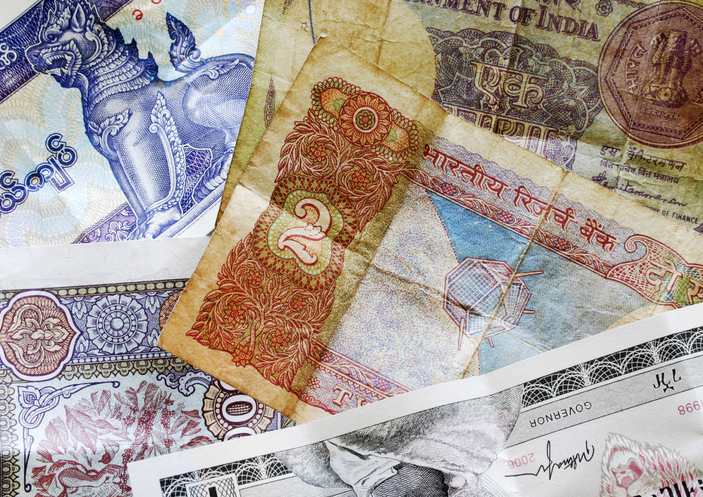For These Collectors, It’s Still All About the Cash
Rare banknotes can yield big bucks, if you know what to look for
Even as the world increasingly moves toward digitised commerce, where transactions are conducted with the tap of a credit card and billions of dollars are moved electronically between banks, there is one group of people for whom hard cash is still king: collectors.
As an alternative asset class, collectible banknotes offer significant potential value to investors, and the market for these paper artefacts is thriving. Aris Maragoudakis , director of world currency auctions at Stack’s Bowers Galleries in Costa Mesa, Calif., estimates the hobby sees annual trade of well over $500 million globally.
In fiscal year 2016, the World Paper Money department at Stack’s recorded about $4 million in sales. By fiscal year 2024, this figure had risen to $14.5 million. The company reported an 18% increase in sales for world paper money (which doesn’t include U.S. paper-money numbers) in fiscal year 2023, followed by 25% growth in fiscal year 2024.
Elsewhere, the Noonans Mayfair London realised £5 million, or about $6.5 million, in world banknote sales in 2023, up from £2.5 million the previous year, a representative said.
The rise of digital technology has helped broaden the base of collectors. Online auctions, forums and databases have made it easier for collectors to connect, trade and research. Greater access to information about collectible money, as well as to collectible banknotes themselves, have transformed the hobby from a game of chance to a strategic pursuit where enthusiasts can actively search for and acquire valuable pieces.
“The advent of social media such as Instagram and WhatsApp have brought in a spate of new collectors, especially youngsters,” says Rezwan Razack , a specialist in vintage banknotes and chairman of the Indian chapter of the International Bank Notes Society, or IBNS.
While social media has made more people aware of older paper currencies and their histories, the declining use of physical banknotes has made them even more alluring and fascinating to collectors.
Where is the value?
Banknotes routinely become obsolete due to political shifts, security upgrades, monetary policies and technological advancements. The question is: Which ones are worthy possessions?
A plethora of factors underpin the desirability of collectible paper money. The major ones are:
• Condition: The condition of a piece can have a significant impact on its value. “There are bills that sell for $1,000 with a fold or two, but finding one free of any folds, stains, or tears could be worth several times that,” says Maragoudakis.
The condition of a bill is evaluated based on a 30-point scale ranging from poor to uncirculated crisp. Within each condition, a bill is given a number grade; a higher number—on a scale typically from 1 to 70—means the banknote is in better shape.
For example, a 10,000-yuan note issued in 1951 by the People’s Bank of China, graded Very Fine 20, sold for $150,000 at a Stack’s Bowers auction. Three years later at another Stack’s Bowers auction, a similar note in better condition, graded Almost Uncirculated 50, fetched $358,500.
• Serial number : Banknotes with striking serial numbers are often worth more to collectors than those without. On eBay, a rare polymer £20 bill with the serial number AA44 444444 received 16 bids and sold for more than £317.
A set of four exceptionally rare Chinese 1953 10 yuan notes from the People’s Bank of China recently sold for $432,000 because in addition to their quality, they were consecutive in serial number.
• Scarcity : The appeal and worth of banknotes, as with other collectibles, are often tied to their rarity.
For instance, high-value banknotes were often printed in limited quantities due to their significant purchasing power, says Hakim Hamdani , director at large and a collector at the Netherlands branch of the IBNS. When these high-denomination notes are discontinued, many people cash them in rather than keeping them as collectibles.
Take the 1921 10,000-shilling note from British East Africa (now Kenya and Tanzania), of which few were printed and issued. At that time, it was equivalent to about $2,000, a substantial sum in 1920s colonial Africa. When they were demonetized, most were redeemed, making the few remaining in private hands highly desirable.
Dennis Hengeveld , president of World Banknote Auctions in Sacramento, Calif., says that depending on the condition, some of these notes have fetched between $35,000 and just over $100,000 at auctions.
A rare $500 Canadian bill from 1911 brought C$528,750 (about $386,400) at a recent auction, the largest sum ever paid for a Canadian banknote. The specimen features the image of Queen Mary and is one of only four of the bills known to exist.
• Error notes : Governments often withdraw banknotes from circulation to deter counterfeiting, but also due to printing anomalies such as incorrect signatures, numerical discrepancies, misprints and typographical errors. Such deviations can elevate their value among enthusiasts.
In the U.S., double denominations—such as a front displaying a $10 bill and the reverse displaying a $20 bill—are the most prized error notes. The value of some of these pieces could top $85,000, according to Heritage Auctions.
How can I get started?
Despite the potential for a lucrative return, experts say the primary motivation for building a collection should be enjoyment and an appreciation of the history that banknotes provide. It would be best to build a collection with the idea of having fun, says Hengeveld of World Banknote Auctions, which was recently acquired by Stack’s Bowers.
Of course, it’s essential to do your due diligence to avoid fraud. Always buy notes from established dealers and confirm their authenticity with reputable grading services. Independent grading companies such as Paper Money Guaranty and Professional Coin Grading Service provide authentication and grading to ensure notes are genuine and their condition accurately assessed.
Auction houses and local dealers offer currency notes in different price ranges. Online retailers (eBay, Amazon.com, Collectibles & Currency), dealers and galleries (Certified Coin Exchange, George H. LaBarre), and numismatic shows (the MIF Paper Money Fair and World’s Fair of Money) are other useful sources.
As well, there is no shortage of stories where people discovered highly valuable collectible banknotes in attics, books, dressers and photo frames of deceased family members. In Ontario, a rare Canadian $500 bill from 1911 was discovered among the personal belongings of a deceased individual. The nearly discarded banknote, one of only three in existence, brought $322,000 at auction.
Those looking to dip their toes into collectible money may find valuable insights in trade magazines including Bank Note Reporter and the Greensheet, or books such as the U.S. Error Note Encyclopedia and Standard Guide to Small-Size U.S. Paper Money.
Additionally, Paper Money Guaranty, the Smithsonian Learning Lab and other websites can offer a wealth of information on various aspects of grading, collecting and how to properly care for banknotes.
 Copyright 2020, Dow Jones & Company, Inc. All Rights Reserved Worldwide. LEARN MORE
Copyright 2020, Dow Jones & Company, Inc. All Rights Reserved Worldwide. LEARN MORE
Records keep falling in 2025 as harbourfront, beachfront and blue-chip estates crowd the top of the market.
A divide has opened in the tech job market between those with artificial-intelligence skills and everyone else.
JPMorgan Chase has a ‘strong bias’ against adding staff, while Walmart is keeping its head count flat. Major employers are in a new, ultra lean era.
It’s the corporate gamble of the moment: Can you run a company, increasing sales and juicing profits, without adding people?
American employers are increasingly making the calculation that they can keep the size of their teams flat—or shrink through layoffs—without harming their businesses.
Part of that thinking is the belief that artificial intelligence will be used to pick up some of the slack and automate more processes. Companies are also hesitant to make any moves in an economy many still describe as uncertain.
JPMorgan Chase’s chief financial officer told investors recently that the bank now has a “very strong bias against having the reflective response” to hire more people for any given need. Aerospace and defense company RTX boasted last week that its sales rose even without adding employees.
Goldman Sachs , meanwhile, sent a memo to staffers this month saying the firm “will constrain head count growth through the end of the year” and reduce roles that could be more efficient with AI. Walmart , the nation’s largest private employer, also said it plans to keep its head count roughly flat over the next three years, even as its sales grow.
“If people are getting more productive, you don’t need to hire more people,” Brian Chesky , Airbnb’s chief executive, said in an interview. “I see a lot of companies pre-emptively holding the line, forecasting and hoping that they can have smaller workforces.”
Airbnb employs around 7,000 people, and Chesky says he doesn’t expect that number to grow much over the next year. With the help of AI, he said he hopes that “the team we already have can get considerably more work done.”
Many companies seem intent on embracing a new, ultralean model of staffing, one where more roles are kept unfilled and hiring is treated as a last resort. At Intuit , every time a job comes open, managers are pushed to justify why they need to backfill it, said Sandeep Aujla , the company’s chief financial officer. The new rigor around hiring helps combat corporate bloat.
“That typical behavior that settles in—and we’re all guilty of it—is, historically, if someone leaves, if Jane Doe leaves, I’ve got to backfill Jane,” Aujla said in an interview. Now, when someone quits, the company asks: “Is there an opportunity for us to rethink how we staff?”
Intuit has chosen not to replace certain roles in its finance, legal and customer-support functions, he said. In its last fiscal year, the company’s revenue rose 16% even as its head count stayed flat, and it is planning only modest hiring in the current year.
The desire to avoid hiring or filling jobs reflects a growing push among executives to see a return on their AI spending. On earnings calls, mentions of ROI and AI investments are increasing, according to an analysis by AlphaSense, reflecting heightened interest from analysts and investors that companies make good on the millions they are pouring into AI.
Many executives hope that software coding assistants and armies of digital agents will keep improving—even if the current results still at times leave something to be desired.
The widespread caution in hiring now is frustrating job seekers and leading many employees within organizations to feel stuck in place, unable to ascend or take on new roles, workers and bosses say.
Inside many large companies, HR chiefs also say it is becoming increasingly difficult to predict just how many employees will be needed as technology takes on more of the work.
Some employers seem to think that fewer employees will actually improve operations.
Meta Platforms this past week said it is cutting 600 jobs in its AI division, a move some leaders hailed as a way to cut down on bureaucracy.
“By reducing the size of our team, fewer conversations will be required to make a decision, and each person will be more load-bearing and have more scope and impact,” Alexandr Wang , Meta’s chief AI officer, wrote in a memo to staff seen by The Wall Street Journal.
Though layoffs haven’t been widespread through the economy, some companies are making cuts. Target on Thursday said it would cut about 1,000 corporate employees, and close another 800 open positions, totaling around 8% of its corporate workforce. Michael Fiddelke , Target’s incoming CEO, said in a memo sent to staff that too “many layers and overlapping work have slowed decisions, making it harder to bring ideas to life.”
A range of other employers, from the electric-truck maker Rivian to cable and broadband provider Charter Communications , have announced their own staff cuts in recent weeks, too.
Operating with fewer people can still pose risks for companies by straining existing staffers or hurting efforts to develop future leaders, executives and economists say. “It’s a bit of a double-edged sword,” said Matthew Martin , senior U.S. economist at Oxford Economics. “You want to keep your head count costs down now—but you also have to have an eye on the future.”
A 30-metre masterpiece unveiled in Monaco brings Lamborghini’s supercar drama to the high seas, powered by 7,600 horsepower and unmistakable Italian design.
In the remote waters of Indonesia’s Anambas Islands, Bawah Reserve is redefining what it means to blend barefoot luxury with environmental stewardship.
























